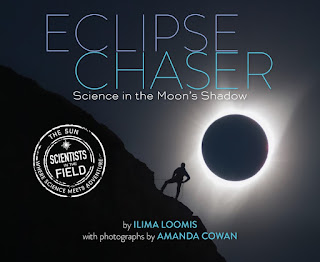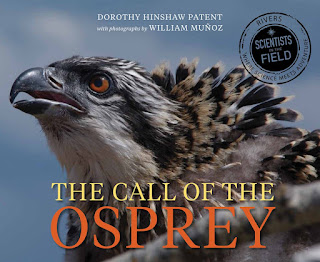4 Books for Young Scientists
When I was in elementary and middle school, serious science
nonfiction geared to my age group that was engaging, accessible, and
informative was fairly nonexistent. Today's young scientists are lucky
to have Houghton Mifflin Harcourt in their court.
Their
Scientists in the Field series and other science titles are some of my
favorites, and I'm long past the middle grades. No matter the topic, I
always learn something new in HMH's science books, and recommend them to
readers of all ages. Note that HMH provides reader guides for these titles, perfect for educators, homeschoolers, and anyone who wants to know more.
Here is the latest batch of HMH
nonfiction to cross my desk. The books have taken me to space, to the past, to my own
backyard, and to lakes of my childhood. Let's take a look.
 Eclipse Chaser: Science in the Moon's Shadow by Ilima Loomis with photographs by Amanda Cowan
(Dec. 2019) focuses on the August 21, 2017, total solar eclipse, which
was visible in North America. I was one of the millions who donned my
special glasses to watch as the moon cast its shadow across the sun. My
prep was to order the glasses, but Shadia Habbal, an astronomer at the
University of Hawaii, spent many months preparing for the 2017 event and
many years traveling the world to observe other total eclipses of the
sun. Her specialty is the sun's corona and solar winds and their effect
on our technology and even our climate. A total eclipse offers her the
best chance to study the sun's surface, to test her hypotheses, and to
further our knowledge.
Eclipse Chaser: Science in the Moon's Shadow by Ilima Loomis with photographs by Amanda Cowan
(Dec. 2019) focuses on the August 21, 2017, total solar eclipse, which
was visible in North America. I was one of the millions who donned my
special glasses to watch as the moon cast its shadow across the sun. My
prep was to order the glasses, but Shadia Habbal, an astronomer at the
University of Hawaii, spent many months preparing for the 2017 event and
many years traveling the world to observe other total eclipses of the
sun. Her specialty is the sun's corona and solar winds and their effect
on our technology and even our climate. A total eclipse offers her the
best chance to study the sun's surface, to test her hypotheses, and to
further our knowledge.
Loomis gives it to us straight,
from the logistics of setting up multiple teams at multiple viewing
sites to the things that can't be controlled like bad weather and a
harsh environment. Loomis's accurate and easy-to-understand
explanations, enhanced with drawings and Cowan's (and other
photographers') amazing photographs, make it easy to connect with
Habbal's work. We see multiple photos of the eclipse as well as how
the temporary field stations are set up and other behind-the-scenes
activities. We feel Habbal's worries and her excitement, and we learn
how scientists and technologists and everyday people come together to
share knowledge and resources. The 2017 data are still being analyzed,
but Habbal is already planning for the next total solar eclipse, which
will take her South America.
 Life on Earth: The Story of Evolution by Steve Jenkins
(paperback: Jan. 28, 2020). Although not as detailed as the Scientists
in the Field books, Jenkins presents an illustrated outline of evolution
from the planet's beginnings to the modern era. Jenkins's watercolor
cut–paper collages capture our imaginations, and the text gives us an
accurate snapshot of how life on Earth came to be. I love the colorful
illustrations of everything from one-celled bacteria to huge dinosaurs
(see the cover for a hint). Jenkins introduces us to Darwin and his
finches and then explains genetic variation and mutation and the
development of new species as well as the extinction of others, through
the process of natural selection. Although geared to a younger audience
than the other books I'm reviewing today, Life on Earth will
spark the interest of the paleontologists and biologists of the future
and will have them heading to the library to explore the suggested
readings listed at the back of the book.
Life on Earth: The Story of Evolution by Steve Jenkins
(paperback: Jan. 28, 2020). Although not as detailed as the Scientists
in the Field books, Jenkins presents an illustrated outline of evolution
from the planet's beginnings to the modern era. Jenkins's watercolor
cut–paper collages capture our imaginations, and the text gives us an
accurate snapshot of how life on Earth came to be. I love the colorful
illustrations of everything from one-celled bacteria to huge dinosaurs
(see the cover for a hint). Jenkins introduces us to Darwin and his
finches and then explains genetic variation and mutation and the
development of new species as well as the extinction of others, through
the process of natural selection. Although geared to a younger audience
than the other books I'm reviewing today, Life on Earth will
spark the interest of the paleontologists and biologists of the future
and will have them heading to the library to explore the suggested
readings listed at the back of the book.
 Crow
Smarts: Inside the Brain of the World's Brightest Bird by Pamela S.
Turner with photos by Andy Comins and art by Guido Filippo
(paperback: Jan. 14, 2020). Ever since I read a study showing that
crows could recognize human faces and could remember who treated them
nicely and who did not, I've been fascinated with the intelligence of
the familiar backyard bird. In this Scientists in the Field book, I
learned about crows' natural abilities to manipulate their environment
and use tools to get what they want. How do they learn such skills? In a
way that is similar to ours: they watch their parents and then practice
on their own. Turner takes us to a New Caledonian forest, where we see
the methods Dr. Gavin Hunt of the University of Aukland uses to study how
these smart birds break open nuts, trick grubs into coming out in the
open, and make hooked tools from pandanus plants.
Crow
Smarts: Inside the Brain of the World's Brightest Bird by Pamela S.
Turner with photos by Andy Comins and art by Guido Filippo
(paperback: Jan. 14, 2020). Ever since I read a study showing that
crows could recognize human faces and could remember who treated them
nicely and who did not, I've been fascinated with the intelligence of
the familiar backyard bird. In this Scientists in the Field book, I
learned about crows' natural abilities to manipulate their environment
and use tools to get what they want. How do they learn such skills? In a
way that is similar to ours: they watch their parents and then practice
on their own. Turner takes us to a New Caledonian forest, where we see
the methods Dr. Gavin Hunt of the University of Aukland uses to study how
these smart birds break open nuts, trick grubs into coming out in the
open, and make hooked tools from pandanus plants.
Besides
learning about crows and seeing them in action through photographs and
drawings, we also learn about the ecology of New Caledonia and how human
activity is threatening the environment. Hunt's observations and
experiments have shown that crows do not act only on blind instinct;
they use their brains to solve problems and enhance their survival. I
had no idea of the extent of crow intelligence, and after reading this
book, I'll never look at a crow the same way again. I like our
neighborhood flock and always hope the crows recognize me as a friend.
 The Call of the Osprey by Dorothy Hinshaw Patent with photography by William Munoz
(paperback: Jan. 21, 2020): Although I've watched ospreys on wildlife
cams on the internet and have seen at least the remnants of their nests
along rivers and lakes, I didn't know much about them except that they
mate for life and return year after year to same nest after their
winters in the south. Patent takes us to osprey homes both in fairly
remote areas and along urban waterways. We see how humans have erected
platforms to encourage ospreys to settle in their area and how the
cameras are set up to allow scientists to watch osprey couples raise
their young from egg to independence.
The Call of the Osprey by Dorothy Hinshaw Patent with photography by William Munoz
(paperback: Jan. 21, 2020): Although I've watched ospreys on wildlife
cams on the internet and have seen at least the remnants of their nests
along rivers and lakes, I didn't know much about them except that they
mate for life and return year after year to same nest after their
winters in the south. Patent takes us to osprey homes both in fairly
remote areas and along urban waterways. We see how humans have erected
platforms to encourage ospreys to settle in their area and how the
cameras are set up to allow scientists to watch osprey couples raise
their young from egg to independence.
Did you know that
ospreys can live to 20 years? That the females are bigger than the
males? Through Patent, we follow three scientists from the University of
Montana, who teach us about osprey behavior, including hunting and
migration patterns, and how they've been affected by a human-filled
world. One of the things I love about the Scientists in the Field books
is that we see the researchers as real people and discover conducting
research in the elements isn't always pleasant, though the discoveries
can make it all worth while. The main focus of the osprey research in
this book is on conservation and pollution and how the birds act as
barometers, offering insights into the state of the natural world and
the status of environmental clean-up projects. The book ends with
resources for getting involved in conservation programs and for learning
more.












5 comments:
Nice range of books and I think I’ll get all of them from our library. There is so many books to offer and interest the younger generation these days. I’m jnot st reading about an eclipse chaser in the novel He Said, She Said by Erin Kelly.
All of those books look fabulous and are probably right at my level.
These books sound so cool! I think my husband would love the one about crows.
I was unaware of these books. They sound great! Today's kids are luckier than we were! :--)
Yes these days they do have such amazing science for young and we not so young can learn from. I have a 6 year old nephew and I see him leaning toward the NF side of things. Life on Earth looks like the book I need to note - for himself and... me!
Post a Comment